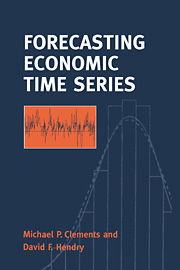Book contents
- Frontmatter
- Contents
- List of figures
- List of tables
- Preface
- Common acronyms
- 1 An introduction to forecasting
- 2 First principles
- 3 Evaluating forecast accuracy
- 4 Forecasting in univariate processes
- 5 Monte Carlo techniques
- 6 Forecasting in cointegrated systems
- 7 Forecasting with large-scale macroeconometric models
- 8 A theory of intercept corrections: beyond mechanistic forecasts
- 9 Forecasting using leading indicators
- 10 Combining forecasts
- 11 Multi-step estimation
- 12 Parsimony
- 13 Testing forecast accuracy
- 14 Postscript
- Glossary
- References
- Author index
- Subject index
7 - Forecasting with large-scale macroeconometric models
Published online by Cambridge University Press: 02 November 2009
- Frontmatter
- Contents
- List of figures
- List of tables
- Preface
- Common acronyms
- 1 An introduction to forecasting
- 2 First principles
- 3 Evaluating forecast accuracy
- 4 Forecasting in univariate processes
- 5 Monte Carlo techniques
- 6 Forecasting in cointegrated systems
- 7 Forecasting with large-scale macroeconometric models
- 8 A theory of intercept corrections: beyond mechanistic forecasts
- 9 Forecasting using leading indicators
- 10 Combining forecasts
- 11 Multi-step estimation
- 12 Parsimony
- 13 Testing forecast accuracy
- 14 Postscript
- Glossary
- References
- Author index
- Subject index
Summary
We now establish a framework for analysing some of the problems that arise in using large-scale macroeconometric models for forecasting. A number of facets of the real-world forecasting venture complicate the picture compared to the analyses of chapters 4 and 6, and each may contribute to forecast errors. A taxonomy of sources of forecast error is developed to enable a systematic treatment of these issues, along with the sources of error covered in earlier chapters. The taxonomy comprises five major categories, namely parameter non-constancy, model mis-specification, sampling variability, variable mis-measurement and error uncertainty, and suggests partial remedies. The potential impact of forecasts, or expectations, on outcomes (the ‘bandwagon effect’ of section 1.3) arises naturally in the taxonomy as a form of variable uncertainty. We also discuss some of the techniques commonly used to evaluate large-scale macroeconometric models.
- Type
- Chapter
- Information
- Forecasting Economic Time Series , pp. 157 - 179Publisher: Cambridge University PressPrint publication year: 1998

